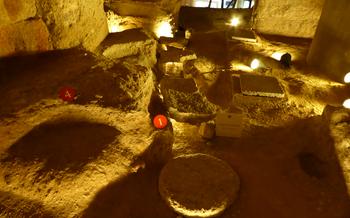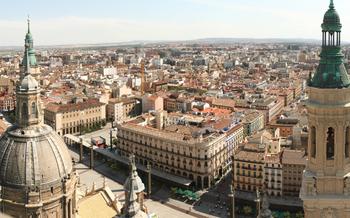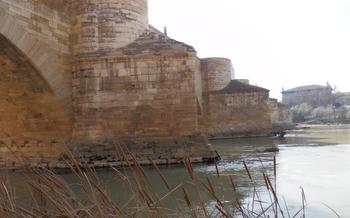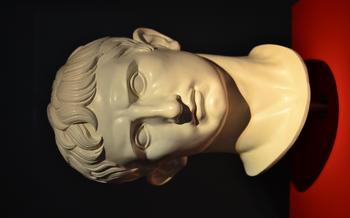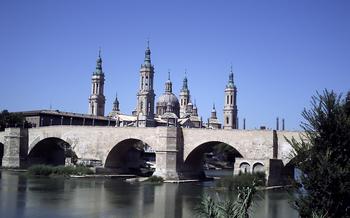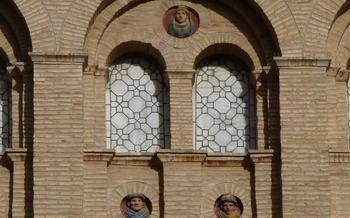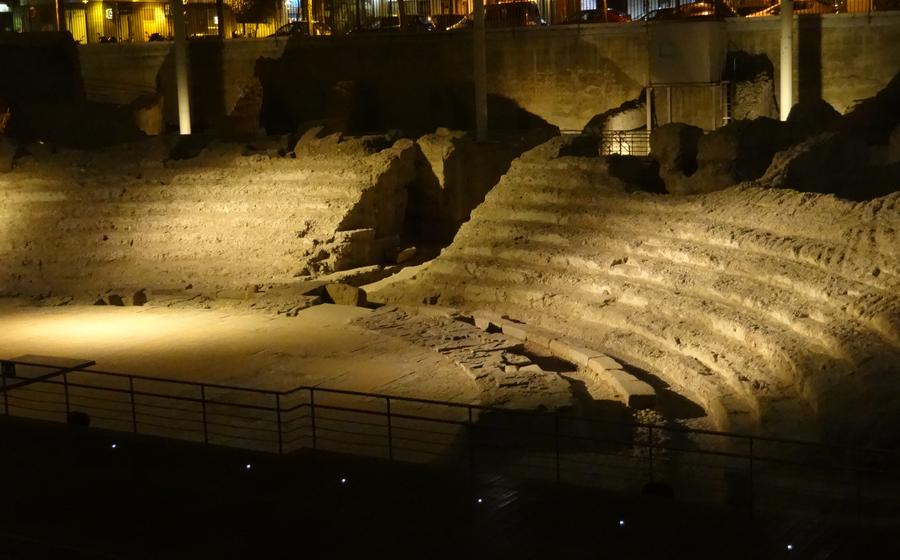
Zaragoza Roman Theatre
- Zaragoza Roman Theatre: Antiquity Monument in Aragon
- Unveiling the Past: A Journey Through Time
- Location and Accessibility: Finding the Hidden Gem
- Opening Hours and Admission Fees: Planning Your Visit
- A Visual Masterpiece: Exploring the Architectural Features
- Echoes of History: Performances and Events
- Unveiling the Secrets: Guided Tours and Exploration
- A Photographer's Paradise: Capturing the Essence
- Step Back in Time: The Interpretation Centre
- Souvenirs and Mementos: Preserving the Memories
- Accessibility for All: Ensuring Inclusivity
- Local Delights: Dining and Refreshments Nearby
- Combining History and Nature: Exploring the Area
- The Roman Theatre in Literature and Art: Cultural Legacy
- Insider Tip: Hidden Secrets and Local Insights
Zaragoza Roman Theatre: Antiquity Monument in Aragon
The Zaragoza Roman Theatre proudly stands as a testament to the rich history of the city. Built in the 1st century BC, during the reign of Emperor Augustus, this ancient theatre served as a prominent venue for theatrical performances, gladiator fights, and public gatherings. Its strategic location on the banks of the Ebro River, a critical trade route, allowed for easy access and transportation of goods and people. The theatre's existence reflects Zaragoza's significance as a thriving Roman city, known as Caesaraugusta, and its vital role in the Roman Empire.
Unveiling the Past: A Journey Through Time
Zaragoza's Roman Theatre stands as a testament to the city's rich history, offering a glimpse into the daily lives of its ancient inhabitants. During the Roman period, Zaragoza flourished as a significant city within the vast Roman Empire. The theatre served as a central hub for entertainment and cultural expression, hosting a variety of performances and events that brought the community together.
Audiences would gather within the theatre's cavea, or seating area, to witness theatrical productions, musical performances, and even gladiatorial contests. These events played a crucial role in Roman society, providing both entertainment and a sense of unity among the citizens. The theatre also served as a venue for religious ceremonies and civic gatherings, further solidifying its importance as a central meeting point for the community.
Exploring the Zaragoza Roman Theatre is like embarking on a journey through time, allowing visitors to connect with the past and imagine the vibrant atmosphere that once filled its ancient walls. As you wander through the theatre's ruins, you can almost hear the echoes of laughter, applause, and the passionate voices of actors and performers who once graced its stage.
Location and Accessibility: Finding the Hidden Gem
The Zaragoza Roman Theatre is nestled in the heart of the city, just a stone's throw away from the picturesque Plaza de San Bruno. To reach this ancient treasure, you can either stroll through the charming streets of Zaragoza or take advantage of the excellent public transportation system. The closest tram stop is "Plaza San Bruno," which is just a short walk from the theatre. Several bus lines also stop nearby, including lines 21, 23, 31, and 3
For those arriving by car, limited parking is available on the streets surrounding the theatre. However, it's worth noting that the area can be quite busy, so finding a spot may be challenging. To avoid the hassle, consider using public transportation or opting for one of the nearby parking garages.
Once you arrive, you'll be greeted by the theatre's impressive façade, which has been meticulously restored to its former glory. Take a moment to admire the intricate carvings and architectural details that adorn the entrance before stepping inside to discover the wonders that await.
Opening Hours and Admission Fees: Planning Your Visit
Current opening hours: - The Zaragoza Roman Theatre welcomes visitors from Tuesday to Sunday. - Opening hours generally run from 10:00 AM to 2:00 PM and from 4:00 PM to 6:00 PM. - Seasonal variations may occur, so checking the latest information on the official website or contacting the theatre directly is advisable.
Admission fees: - Standard ticket prices for adults are set at [Insert Standard Price]. - Concessions are available for students, seniors, and groups, offering discounted rates. - Guided tours typically come with an additional charge and offer an immersive experience with insights from knowledgeable guides.
Advance booking recommendations: - To avoid queues and ensure a hassle-free visit, pre-booking tickets online is highly recommended. - This allows you to secure your spot, especially during peak tourist seasons or for specific events.
A Visual Masterpiece: Exploring the Architectural Features
The Zaragoza Roman Theatre showcases an impressive layout and structure, a testament to the architectural prowess of the ancient Romans. The theatre features a semi-circular arrangement of seating, known as the cavea, which could accommodate up to 6,000 spectators. The cavea is divided into three sections: the ima cavea, media cavea, and summa cavea, each representing different social classes.
The stage, or scaena, is another notable architectural element of the theatre. It consists of a raised platform with a backdrop of intricate frescoes and decorative elements. The scaena provided a dynamic performance space for actors and musicians, enhancing the overall theatrical experience.
The Zaragoza Roman Theatre stands out for its unique design compared to other Roman theatres. Its smaller size and intimate atmosphere create a sense of closeness between performers and spectators, making it an ideal venue for both dramatic and musical performances. The theatre's well-preserved state, combined with its distinctive architectural features, makes it a captivating attraction for visitors interested in ancient history and architecture.
Echoes of History: Performances and Events
The Zaragoza Roman Theatre's rich history extends beyond its original function as a venue for theatrical performances. Throughout the centuries, it has played host to a diverse range of events, echoing with laughter, applause, and the murmur of captivated audiences. In ancient times, the theatre reverberated with the voices of actors performing comedies, tragedies, and satires, transporting spectators to distant lands and mythical realms.
In modern times, the theatre has undergone a revival, once again becoming a vibrant stage for cultural expression. Every summer, the "Festival Internacional de Teatro Clásico de Zaragoza" (International Classical Theatre Festival of Zaragoza) brings the theatre back to life, showcasing an array of classical and contemporary performances, both local and international. These productions, set against the backdrop of the ancient ruins, create a magical atmosphere that transports audiences back in time.
Beyond theatrical performances, the theatre also hosts concerts, dance recitals, and other cultural events throughout the year. These events breathe new life into the ancient space, transforming it into a vibrant hub of artistic expression. Attending an event at the Zaragoza Roman Theatre is not just a cultural experience but a journey through time, connecting visitors with the theatre's rich past while immersing them in the vibrant present.
Unveiling the Secrets: Guided Tours and Exploration
Enhance your visit to the Zaragoza Roman Theatre by embarking on a captivating guided tour. Conducted in multiple languages, these tours offer an immersive journey through the theatre's rich history and architectural marvels. The knowledgeable guides will regale you with tales of the theatre's past, shedding light on its significance during Roman times.
The standard guided tour typically lasts for approximately 45 minutes, taking you on a comprehensive exploration of the theatre's layout, seating arrangements, stage, and other notable features. You'll gain insights into the theatre's original function, the types of performances held, and its role as a symbol of Roman culture in Zaragoza.
To book a guided tour, you can either reserve your spot online or directly at the theatre's ticket office. Fees for guided tours vary depending on the group size and language preference. It's advisable to book in advance, especially during peak tourist seasons, to secure your preferred time and language.
Make the most of your guided tour experience by actively engaging with the guide, asking questions, and seeking clarifications. Remember to capture the theatre's grandeur through photographs, but be mindful of any restrictions on photography within the premises.
Whether you're a history buff, an architecture enthusiast, or simply curious about Roman culture, a guided tour of the Zaragoza Roman Theatre promises an enriching and memorable experience.
A Photographer's Paradise: Capturing the Essence
The Zaragoza Roman Theatre offers a picturesque backdrop for photography enthusiasts. With its stunning architecture and historical charm, the theatre presents a captivating subject for capturing timeless shots. The best angles can be found from various vantage points within the theatre, allowing you to capture the grandeur of the structure from different perspectives. Ideally, plan your visit during the golden hours of sunrise or sunset to take advantage of the warm, diffused lighting that enhances the theatre's features. Experiment with different focal lengths and compositions to create unique and captivating images. Share your stunning captures on social media using relevant hashtags to inspire other travelers and photography enthusiasts to explore the beauty of the Zaragoza Roman Theatre.
Step Back in Time: The Interpretation Centre
Adjacent to the Zaragoza Roman Theatre lies a treasure trove of knowledge and history - the Interpretation Centre. This modern facility serves as a gateway to understanding the theatre's significance and immersing visitors in the Roman era. Upon entering, you'll be greeted by a captivating array of exhibits and displays that bring the theatre's past to life.
Interactive elements and multimedia presentations engage visitors of all ages, providing a comprehensive journey through time. Learn about the theatre's construction, its role in Roman society, and the daily lives of the people who once graced its stage. Discover the architectural wonders of the theatre, from its intricate mosaics to its impressive stage design.
The Interpretation Centre is not just a repository of information; it's an experience that transports you back in time. Through its immersive exhibits, you'll gain a deeper appreciation for the Roman Theatre and its enduring legacy. Whether you're a history buff, an architecture enthusiast, or simply curious about the past, the Interpretation Centre is a must-visit destination.
Tips for a Fulfilling Visit:
- Allow ample time to explore the exhibits and engage with the interactive displays.
- Take advantage of the audio guides available in multiple languages for a comprehensive understanding.
- The Interpretation Centre is wheelchair accessible, ensuring inclusivity for all visitors.
- Combine your visit with a guided tour of the Roman Theatre for a well-rounded experience.
- Don't forget to capture your memorable moments at the Interpretation Centre and share them on social media using relevant hashtags.
Souvenirs and Mementos: Preserving the Memories
As you bid farewell to the awe-inspiring Zaragoza Roman Theatre, don't forget to take a piece of its history home with you. A visit to the gift shop or souvenir store is a must for any history enthusiast or collector. Here, you'll find a treasure trove of items that pay homage to this ancient wonder. From intricately designed replicas of the theatre to books detailing its rich history, there's something for everyone.
The souvenirs available at the Roman Theatre are not just ordinary trinkets; they are meticulously crafted to reflect the authenticity and grandeur of the site. Whether you choose a ceramic model of the theatre, an elegant scarf adorned with Roman motifs, or a commemorative coin, each item holds a special significance. These souvenirs serve as tangible reminders of your visit, allowing you to relive the magic long after you've left Zaragoza.
When selecting a souvenir, take your time to browse the diverse collection and choose something that resonates with you. Consider items that capture the essence of the theatre, such as a replica of a Roman coin or a miniature statue of a gladiator. These unique souvenirs will not only adorn your home but also spark conversations and ignite your imagination.
Remember, these souvenirs are more than just keepsakes; they are tangible links to a bygone era, a reminder of the enduring legacy of the Zaragoza Roman Theatre. As you cherish these mementos, you become a part of the theatre's ongoing story, ensuring that its significance lives on for generations to come.
Accessibility for All: Ensuring Inclusivity
The Zaragoza Roman Theatre is committed to ensuring that all visitors, regardless of their abilities, can enjoy and appreciate this historical landmark. Accessibility features have been implemented to create an inclusive environment for visitors with disabilities. Ramps and elevators provide easy access to different levels of the theatre, allowing wheelchair users to navigate the site without difficulty. Designated areas within the seating sections are reserved for wheelchair users, ensuring unobstructed views of performances or events. Visitors with hearing impairments can request assistive listening devices to enhance their experience. Additionally, guided tours are available in sign language or with audio description to accommodate visitors with visual impairments. The theatre staff is dedicated to providing assistance and support to ensure that every visitor has a memorable and enriching experience.
Local Delights: Dining and Refreshments Nearby
When you're done exploring the Roman Theatre, you'll likely be ready to refuel. Luckily, there are many great dining options nearby. For a taste of local cuisine, try one of the many traditional Spanish restaurants, where you can indulge in dishes like paella, tapas, or zarangollo. If you're looking for something a little different, there are also several international restaurants to choose from, offering everything from Italian to Japanese cuisine.
No matter what your taste, you're sure to find something to your liking near the Roman Theatre. And if you're looking for a place to relax and have a drink, there are several bars and cafes in the area as well. So take some time to explore the culinary delights of Zaragoza and make your visit to the Roman Theatre a truly memorable experience.
Here are a few specific recommendations:
- El Tubo: This historic district is home to a variety of tapas bars, where you can sample traditional Spanish cuisine in a lively atmosphere.
- El Mercado Central: This bustling market is a great place to find fresh produce, seafood, and other local delicacies. You can also find a number of restaurants and cafes here, where you can enjoy a meal or a snack.
- La Lonja: This former fish market is now home to a number of restaurants and bars, offering a variety of cuisines from around the world.
- El Casco Antiguo: This charming old town is home to a number of hidden gems, including traditional Spanish restaurants, tapas bars, and cafes.
Combining History and Nature: Exploring the Area
Beyond the Roman Theatre, Zaragoza offers an array of attractions to complement your historical exploration. Just a stone's throw away, the stunning Cathedral-Basilica of Our Lady of the Pillar awaits, showcasing a blend of architectural styles from Gothic to Renaissance. A short stroll along the Ebro River will lead you to the serene Parque del Agua Luis Buñuel, a haven of tranquility with its lush gardens, playgrounds, and picturesque bridges.
For art enthusiasts, the nearby Pablo Serrano Museum showcases a captivating collection of contemporary sculptures, while the Goya Museum houses an impressive array of works by the renowned painter Francisco de Goya. To delve deeper into Zaragoza's rich past, the Museum of Zaragoza offers a fascinating journey through the city's history and culture, from its Roman roots to its modern-day evolution.
Whether you seek further historical immersion or a refreshing break amidst nature, Zaragoza's diverse attractions provide a harmonious blend of culture, heritage, and natural beauty, ensuring a well-rounded and unforgettable experience for every traveler.
The Roman Theatre in Literature and Art: Cultural Legacy
The Zaragoza Roman Theatre has not only served as a stage for performances but has also inspired countless works of literature, poetry, and art throughout history. Its enduring presence in the cultural landscape is a testament to its profound impact on the local psyche.
In the realm of literature, the theatre has been immortalized in the works of renowned Spanish authors. Its grandeur and historical significance have captivated the imaginations of poets and novelists, who have woven it into the fabric of their narratives.
The theatre's allure extends beyond the written word. Artists have found inspiration in its majestic form, capturing its essence on canvas and in sculptures. These artistic representations not only showcase the theatre's architectural beauty but also convey the emotions and experiences it has evoked over the centuries.
By transcending its original purpose, the Zaragoza Roman Theatre has become a symbol of cultural heritage and identity. It stands as a testament to the enduring power of art and the ability of historical landmarks to inspire and captivate generations to come.
Insider Tip: Hidden Secrets and Local Insights
Beyond the surface, the Zaragoza Roman Theatre holds a treasure trove of hidden secrets and local insights waiting to be discovered. One intriguing fact is the existence of a subterranean network of tunnels and chambers beneath the theatre, believed to have been used for storage or as escape routes in times of danger. These tunnels are not open to the public, but their existence adds an air of mystery and intrigue to the site.
For an authentic local experience, engage with the friendly and knowledgeable staff at the theatre. They can share fascinating anecdotes and insights about the theatre's history, restoration process, and ongoing events. Don't hesitate to ask questions and immerse yourself in the local culture surrounding this remarkable monument.
As you wander around the theatre, pay attention to the intricate carvings and inscriptions adorning the stone. These often depict scenes from Roman mythology or important historical events, offering a glimpse into the beliefs and values of the ancient Roman society.
Finally, embrace the vibrant atmosphere of the theatre by attending one of the many cultural performances or events held throughout the year. From classical concerts to theatrical productions, these events bring the ancient Roman Theatre back to life, allowing visitors to experience its magic and grandeur in a truly immersive way.
